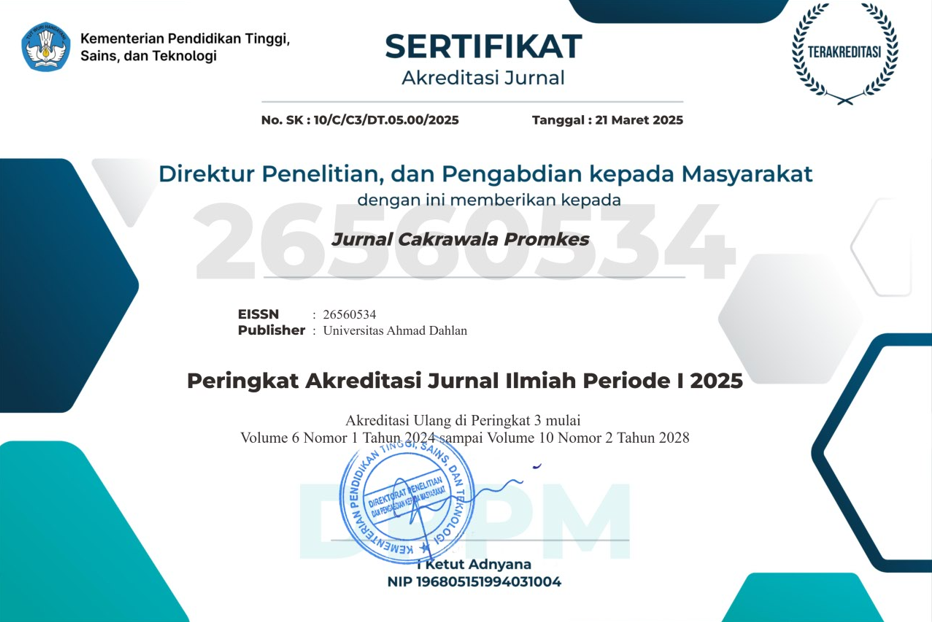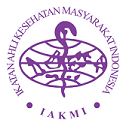Gambaran Riwayat Pemberian Air Susu Ibu dan Status Gizi Balita di Dusun Ratan Kecamatan Batur Kabupaten Banjarnegara
DOI:
https://doi.org/10.12928/promkes.v4i1.4988Keywords:
Breastfeeding, Nutritional Status, Family SupportAbstract
Background: The best food for newborns up to six months of age is breast milk. This is due to the complete nutritional content so that it can meet the baby’s needs. Breastfeeding after the baby is six months old is recommended with complementary feeding. The percentage of exclusive breastfeeding in Banjarnegara Regency in 2019 was 61.4%. History of breastfeeding factors that can influence the nutritional status of children. This study aims to describe the history of breastfeeding and the nutritional status of children in Dusun Ratan, Batur Village, Batur District, Banjarnegara Regency. Method: This study uses a qualitative method with a case study approach. There were nine informants in this study consisting of mothers who had toddlers with the criteria of under-fives being less nutritional status, over nutritional status, and good nutrition status. Collecting data in this study through interviews. Result: Most of the informants gave exclusive breastfeeding. But one of the informants who had a toddler with more nutritional status did not exclusively breastfeed. The knowledge of the informants is not good. This may be related to the level of education of the informants which is still low on average. A mother’s motivation in breastfeeding comes from herself and also her family. Information about breastfeeding was obtained by informants through counseling, KIA books, the internet, articles on breastfeeding, and midwives. Conclusion: The history of exclusive breastfeeding is related to the nutritional status of toddlers, although exclusive breastfeeding is not the only factor that can determine the nutritional status of toddlers. Husband and family
References
(1). Agustia N, Machmud R, Usman E. Faktor yang Berhubungan dengan Pemberian ASI Eksklusif
pada Ibu Bekerja di Kabupaten Ogan Komering Ulu. J Kesehat Andalas. 2019;8(3):573–82.
(2). Dinkes. Profil Kesehatan Provinsi Jawa Tengah Tahun 2019. Vol. 3511351, Profil Kesehatan
Jateng. 2019. 273–275 p.
(3). Dinas Kesehatan Kabupaten Banjarnegara. Profil Kesehatan Kabupaten Banjarnegara 2019.
;1–161.
(4). Kemenkes. Buku Profil Kesehatan Indonesia Tahun 2018. Jakarta: Kementrian Kesehatan
RI; 2019.
(5). Handayani S, Kapota WN, Oktavianto E. Hubungan Status Asi Eksklusif Dengan Kejadian
Stunting Pada Batita Usia 24-36 Bulan Di Desa Watugajah Kabupaten Gunungkidul. Med
Respati J Ilm Kesehat. 2019;14(4):287.
(6). Kemenkes. Situasi dan Analisis ASI Eksklusif. Jakarta: Kementrian Kesehatan RI; 2014.
(7). Utami FA. Best Of The Best MP-ASI Gizi Tepat. Yogyakarta: Okxygen Media Ilmu; 2018.
(8). Masturoh I, Anggita T N. Metodologi Penelitian Kesehatan. Jakarta: Kemenkes RI; 2018.
(9). Purba EA, Kapantow NH, Momongan N. Hubungan Antara Pemberian Asi Eksklusif Dengan
Status Gizi Bayi 6-12 Bulan Di Wilayah Kerja Puskesmas Tatelu Kecamatan Dimembe
Kabupaten Minahasa Utara. Kesmas. 2017;6(4).
(10). Astriyani NPAP. Pengaruh Konseling Pemberian Asi Eksklusif Terhadap Peningkatan Berat
Badan Bayi Di Puskesmas Karang Pule Tahun 2017. Yars Med J. 2018;26(1).
(11). Wainaina CW, Wanjohi M, Wekesah F, Woolhead G, Kimani-Murage E. Exploring the
Experiences of Middle Income Mothers in Practicing Exclusive Breastfeeding in Nairobi,
Kenya. Matern Child Health J [Internet]. 2018;22(4):608–16. Available from:
http://dx.doi.org/10.1007/s10995-018-2430-4
(12). Septikasari M. Status Gizi Anak dan Faktor Yang Mempengaruhi. Yogyakarta: UNY Press;
(13). Kandowangko H, Mayulu N, Punuh MI. Hubungan Antara Pemberian Makanan Pendamping
Asi (MP-ASI) dengan Status Gizi Anak Usia 12-24 Bulan di 5 Puskesmas Kota Manado. JKESMAS ejournalhealth. 2019;7(4).
(14). Lestiarini S, Sulistyorini Y. Perilaku Ibu pada Pemberian Makanan Pendamping ASI (MPASI)
di Kelurahan Pegirian. J PROMKES. 2020;8(1):1.
(15). Yulnefia, Faris AR. HUBUNGAN FREKUENSI PEMBERIAN MAKANAN PENDAMPING ASI
(MP-ASI) DENGAN STATUS GIZI ANAK USIA 6-24 BULAN. Collab Med J. 2020;3(3):123–30.
(16). Nur Hadibah Hanum. Hubungan Tinggi Badan Ibu dan Riwayat Pemberian MP-ASI dengan
Kejadian Stunting pada Balita Usia 24-59 Bulan. Amerta Nutr. 2019;3(2):78–84.
(17). Syariefah SR. Perbandingan Pertumbuhan Bayi Usia 6-12 Bulan yang Diberikan MP-ASI
Lokal dan MP-ASI Instan di Kecamatan Pulau Haruku Kabupaten Maluku Tengah. J Penelit
Kesehat Suara Forikes. 2021;12:186–8.
(18). Zielińska MA, Sobczak A, Hamułka J. Breastfeeding knowledge and exclusive breastfeeding
of infants in first six months of life. Rocz Panstw Zakl Hig. 2017;68(1):51–9.
(19). Rahmawati NI. Pendidikan Ibu Berhubungan Dengan Teknik Menyusui pada Ibu Menyusui
yang Memiliki Bayi Usia 0-12 Bulan. J Ners dan Kebidanan Indones. 2017;5(1).
(20). Ramli R. Correlation of Mothers’ Knowledge and Employment Status with Exclusive
Breastfeeding in Sidotopo. J PROMKES. 2020;8(1):36
Downloads
Published
Issue
Section
License
Copyright (c) 2022 Fini Khafillah, Lina Handayani

This work is licensed under a Creative Commons Attribution-ShareAlike 4.0 International License.
Authors who publish with JCP: Jurnal Cakrawala Promkes agree to the following terms:
- Authors retain copyright and grant the journal the right of first publication with the work simultaneously licensed under a Creative Commons Attribution License (CC BY-SA 4.0) that allows others to share the work with an acknowledgement of the work's authorship and initial publication in this journal.
- Authors are able to enter into separate, additional contractual arrangements for the non-exclusive distribution of the journal's published version of the work (e.g., post it to an institutional repository or publish it in a book), with an acknowledgement of its initial publication in this journal.
- Authors are permitted and encouraged to post their work online (e.g., in institutional repositories or on their website) prior to and during the submission process, as it can lead to productive exchanges, as well as earlier and greater citation of published work.

This work is licensed under a Creative Commons Attribution-ShareAlike 4.0 International License












